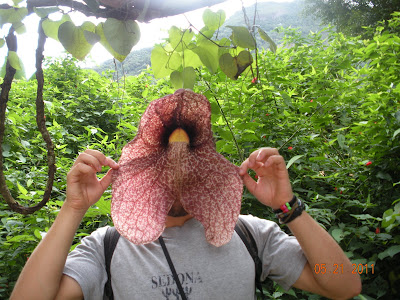Last Friday my lab celebrated by going out to lunch at a fancy restaurant serving fejoada (bean and meat dish) buffet-style. It was up in the top floor of a glamorous high-rise, and the view was pretty nice.
I say pretty nice because compared to the views I get when climbing mountains here its kind of mediocre. But the food was excellent.
I spent the next three hours slumped in my chair at work, trying not to think about all the food inside me, while everyone talked about our lunch...
Botanical Garden
I spent most of Saturday exploring the Botanical Garden here in Rio with Javier. I love plants so it was a lot of fun to see all these amazing news ones put in the same place for me to see. A plant zoo.
This plant wasn't particularly fascinating-looking, but when I crushed up the leaves they had a strong scent of cloves, which was cool.
The biggest tree that I found there
The main paths with lined with giant palm trees. Pretty impressive.
Cacao. You can eat the white fleshy part covering the black seeds (which we use to make chocolate). I tried eating the seeds too, but neither tasted very good. It wasn't ripe, and the seeds need lots of processing, like coffee.
King of the bamboo fortress
Carnivorous plants
Orchids in the orchidarium
Crazy Cacti!
Rare glimpse of a tucan
This tree was full of little monkeys. I got a nice close-up of this guy, usually they shy away from people, and I've heard stories of monkey-bites if you get too close, but he seemed pretty chill.
Pedra da Gavea--Summit number 3
I stayed true to my ritual Sunday morning summiting of Pedra da Gavea. This time I went as light as I could, stashing my backpack tied to a tree in the woods, and hitting the trail barefoot. It was a popular day to hike the trail, and I passed close to 50 people on my way up. I got a lot of strange looks--being a half-naked, sweat covered, barefoot hudlum running and climbing up the trail as fast as I could. But I beat my record (made it up in 52 minutes), and it was a ton of fun.
The view up here never gets old
After descending I trekked out to the beach of Barra de Tijuca. This is a view from the beach, looking back up at Pedra da Gavea, where I had just come from.
According to many, the beach here is more beautiful than Copacabana and Ipanema. Hard to tell, but it certainly was stunning. The beach is less crowded here, and cleaner, but lacks the renoun of the other two. Barra is a wealthy neighborhood and lots of people were out playing with expensive water toys, like kite surfing and jet-skiing. It made for excellent spectating as I enjoyed my half a dozen bananas and package of cookies.
Exodus
This will likely be my last post from Rio, since I leave next Tuesday. The last few weeks really seem to have sped by fast, compared to the first week or two where each day seemed an endless adventure. I think that reflects how comfortable I've gotten here. If I didn't have a schedule (aka airline tickets purchased and limited funding from UW) I could see myself staying here much longer... Already thinking and planning times when I can come back.
I've been (even harder) at work finishing my final report ("Status of Second Generation Ethanol Production in the US and Brazil") and preparing my presentation for tomorrow. My report is in English (as it will be submitted for publishing) but my presentation is in Portuguese. This will be a great test of how much I've learned in the lab, with my work, and with the language.
A salute to all my awesome colleagues here at INT:
Me joining Cristina, Patricia, and Javier in their room. The majority of our "festas" (parties/breaks from work) happen here, since the coffee and snacks happen to be strategically located in their room...
Anete, me, Lorraine, and Cristina in the lab. I get to spend intermittent time helping other people on their projects in the lab rooms. Regretably, the longest day I spent in the lab was when I was cleaning all the counters and equipment, and washing glassware.
Anete, Viridiana, and Livian
I've loved my time here, and will miss all my friends.
Next up is Salvador, where I'll meet up with a friend of my mom's to work with an NGO that runs a school for girls. I'll be doing ground work, taking photos, helping out around the school, and interviewing potential new employees. Or at least thats the plan now, more details to come when I get there.





















































